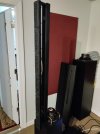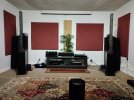Making a baffle less speaker with better drivers seems to be very interesting - what about a Lxmini speaker with better drivers - like a Kef uniQ for the 300 - 20000 Hz and a purifi 8 inch woofer , or a Dayton 8 inch woofer from the reference series . It would then be a 3- way dsp speaker and much bigger than the original Lxmini . The tube for the bassdriver has to be about 20 cm in diametre.
I have been experimenting with putting a baffle around one of my condencer microphones - this made the recorded sound much more diffuse and unclear - why should there be any better result with a broad baffle in a loudspeaker ? - there is clearly a coloration depending on early reflections within 1-5 ms . I think Linkwitz had something very important going on in his latest constructions and he seemed to try to diminish the baffle size and instead correct the frequency response with the help of a dsp .
All you DIY:ers - is this a bad or good idea in a future loudspeaker building project ?

I have been experimenting with putting a baffle around one of my condencer microphones - this made the recorded sound much more diffuse and unclear - why should there be any better result with a broad baffle in a loudspeaker ? - there is clearly a coloration depending on early reflections within 1-5 ms . I think Linkwitz had something very important going on in his latest constructions and he seemed to try to diminish the baffle size and instead correct the frequency response with the help of a dsp .
All you DIY:ers - is this a bad or good idea in a future loudspeaker building project ?
Last edited:


